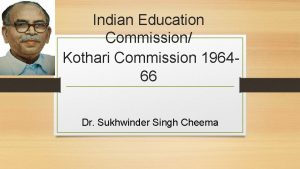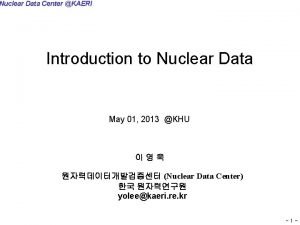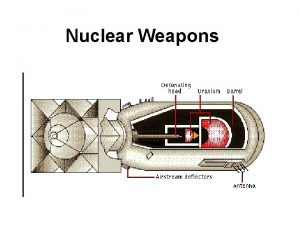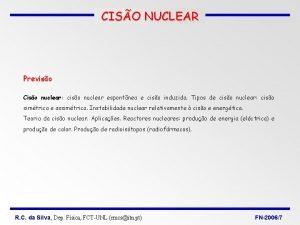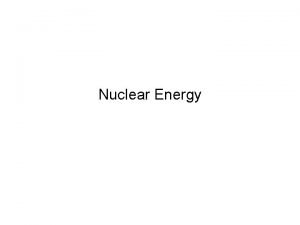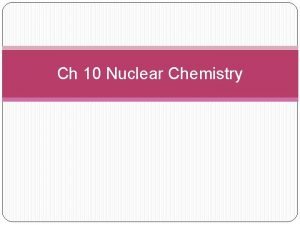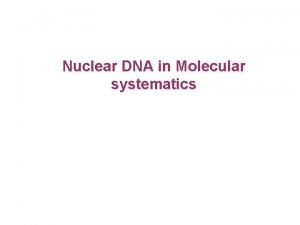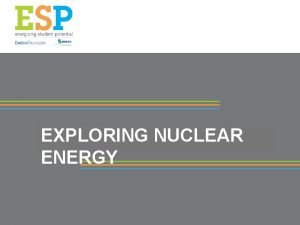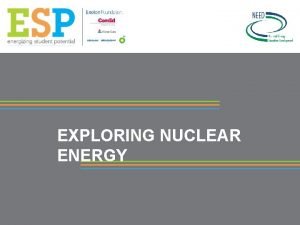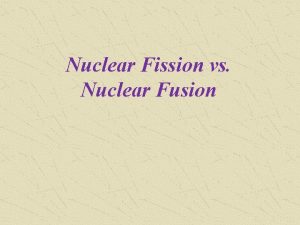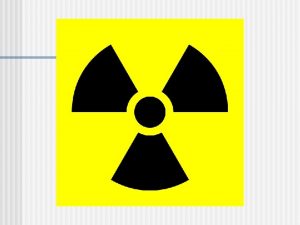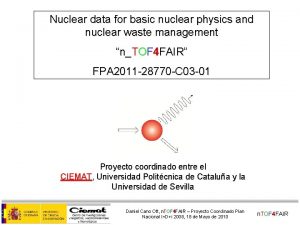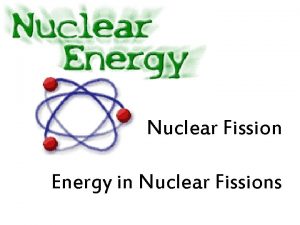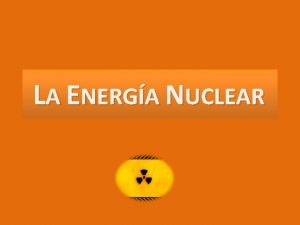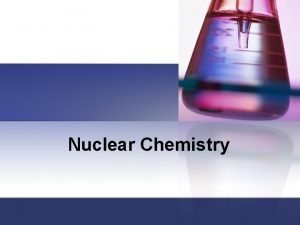NUCLEAR TECHNOLOGY DEVELOPMENT CENTER NATIONAL COMMISSION FOR NUCLEAR





















- Slides: 21

NUCLEAR TECHNOLOGY DEVELOPMENT CENTER NATIONAL COMMISSION FOR NUCLEAR ENERGY Belo Horizonte, Brazil 2 nd International Conference and Expo on Separation Techniques SEPARATION OF CERIUM FROM OTHER RARE EARTH ELEMENTS BY SOLVENTE EXTRACTION Carlos Antônio de Morais Thiago Silveira Formiga Valencia, Spain September 26 -28, 2016

THE PAPER This work presents an investigation of solvent extraction parameters in order to obtain high purity cerium from a liquor containing a mixture of rare earths elements, as an alternative to cerium oxidation and selective RE dissolution. The sample used was a sulfuric liquor obtained from the leaching of monazite, rich in light rare earth elements (La, Ce, Pr, Nd). The experiments were carried out in hydrochloric, nitric and sulphuric media. 2

Introduction The RE are a group of 17 elements composed of the lanthanides, scandium and yttrium 3

Introduction The rare earth elements have extreme importance to advanced technology industry (electronic components, permanent magnets, nuclear medicine, automobile industry, wind turbines, among others). 4

Introduction �The rare earth elements have very similar physical and chemical properties and therefore occur together in different proportions in their mineral sources. Obtaining the individual rare earth elements in industrial scale is very complex and only dominated by a few countries. �This behavior is responsible for the high prices of these elements (difficulties in detection, analysis and commercial extraction). 5

Introduction �Schematic diagram of the continuous SX mixer-settlers counter current system Feed solution Regeneration Extraction Raffinate circuit – SOLVENT Scrubbing Stripping Scrubbing solution Stripped Stripping solution 6

Introduction Solvent extraction Laboratory – CDTN, Brazil 7

Introduction - Cerium Generally the separation of cerium is accomplished by the oxidation of Ce (III) to Ce (IV) following by the selective dissolution of the trivalent REEs. By this technique, the other REEs are usually contaminated with cerium or cerium is contaminated with other rare earth elements, justifying the study of its separation by the solvent extraction technique. 8

Methodology �The Sulphuric liquor was provided by the Nuclear Industries of Brazil S. A. - INB. �Nitric and hydrochloric media were also investigated. �The nitric and hydrochloric solutions were prepared from the sulphuric liquor by precipitation of the rare earths as oxalate, calcination and dissolution of the rare earth elements in nitric or hydrochloric acid. 9

Methodology PARAMETERS INVESTIGATED Extractants: ▪ Solvation extractants (TBP, Cyanex® 923); ▪ Cationic extractants (D 2 EHPA, P 507); ▪ Anionic extractants (Primene®J-MT, Alamine® 336 and Aliquat® 336); Aqueous phase: ▪ The medium (hydrochloric, nitric and sulphuric); ▪ Acidity; Aqueous/organic volumetric ratio; Presence and absence of oxidizing agent. 10

Methodology TBP - tri-n-butyl-phosphate D 2 EHPA - di-2 ethylhexyl phosphoric acid - P 507 - 2 -ethylhexyl mono (2 -ethylhexyl) ester phosphonic acid Alamine® 336 trioctyl/decyl amine Primene®JMT T-Alkyl(C 16 -C 22) primary amine Cyanex® 923 - trialkylphosphine oxide Aliquat® 336 trialkyl-methyl-ammonium-chloride 11

Methodology �Bench extraction experiments Organic phase Extractant RE liquor Agitation (5 min) Aqueous phase 12

Samples Chemical composition of the liquors Sample Sulphuric liquor Hydrochloric liquor Nitric liquor Content (g/L) La Ce Nd Pr Sm Gd Dy Y 6. 7 14. 8 5. 6 1. 5 0. 69 0. 56 0. 16 0. 49 6. 5 14. 6 5. 6 1. 6 0. 70 0. 56 0. 16 0. 47 6. 5 14. 5 5. 7 1. 5 0. 71 0. 56 0. 16 0. 50 13

Results - Sulphuric liquor REE extraction – without oxidant addition It was observed no extraction of REE. High acidity of the liquor – about 1 mol/L H+. The p. H adjustment was unfeasible due to formation a precipitate of double sulfate of rare earth and sodium or ammonium, depending on the basic reagents used (Na. OH, NH 4 OH or Na 2 CO 3). 14

Results - Hydrochloric liquor REE extraction – without oxidant addition Extractant Extraction (%) p. H Separation factor La Ce Pr Nd Ce/La Pr/Ce Nd/Pr P 507 0. 5 0. 7 1. 8 6 7 3. 5 3. 2 1. 2 P 507 1. 0 5. 0 16 37 40 3. 9 3. 2 1. 2 P 507 2. 0 13 37 66 70 4. 1 3. 2 1. 2 D 2 EHPA 0. 5 17 38 61 64 3. 1 2. 7 1. 1 D 2 EHPA 1. 0 36 64 80 82 3. 2 2. 3 1. 1 D 2 EHPA 1. 5 65 86 93 94 3. 3 2. 2 1. 1 15

Results - Hydrochloric liquor – p. H 0 REE extraction – with oxidant addition Extractant Oxidant Extraction (%) La Ce Pr Nd Separation factor Ce/La Pr/Ce Nd/Pr P 507 Na 2 S 2 O 8 6 12 15 17 2. 1 1. 3 1. 2 P 507 K 2 S 2 O 8 7 13 16 18 2. 0 1. 3 1. 2 Na 2 S 2 O 8 16 28 37 42 2. 1 1. 5 1. 1 39 2. 0 1. 5 1. 1 D 2 EHPA K 2 S 2 O 8 16 27 38 Potential: Initial: 550 mv After oxidant addition: 980 mv After extraction : 580 (m. V) 16

Results - Nitric liquor REE extraction – without oxidant addition – p. H 1. 0 Extractant Extraction (%) Separation factor La Ce Pr Nd Ce/La Ce/Pr Nd/Pr Cyanex® 923 98 100 99 99 - - - P 507 7 76 34 36 44 6. 2 1. 1 D 2 EHPA 54 95 91 89 17 2. 6 1. 1 17

Results - Nitric liquor REE extraction – without oxidant addition at different p. H without oxidant addition Extractant p. H P 507 Extraction (%) Separation factor La Ce Pr Nd Ce/La Ce/Pr Nd/Pr 1, 0 7 76 35 36 44 5. 8 1. 0 P 507 2, 0 26 89 80 80 24 2. 2 1. 0 D 2 EHPA 0, 5 25 88 69 69 22 3. 4 1. 0 D 2 EHPA 1, 0 54 93 88 89 16 2. 6 1. 0 D 2 EHPA 1, 5 86 99 98 98 20 2. 2 1. 0 Initial potential: 1460 mv 18

Results - Nitric liquor REE extraction – with oxidant addition - high acidity liquor Oxidant None K 2 S 2 O 8 Ag. NO 3 K 2 S 2 O 8 + Ag. NO 3 Contact 1 st 2 nd Extraction (%) La Ce Pr Nd <1 <1 45 15 45 16 44 19 95 5 <1 <1 <1 <1 Potential Initial: 1460 mv K 2 S 2 O 8 + Ag. NO 3 : 1620 mv Final: 1410 m. V 19

Conclusions �The experiments without the oxidation of cerium (III) to cerium (IV) indicated the difficulty in its separation from the other trivalent REE. �In nitric medium, cerium was preferentially extracted from the other rare earth elements. Using a mixture of potassium persulfate and silver nitrate as oxidizing and P 507 as extractant, 99. 9% recovery with 99. 9% purity was achieved in two stages. 20

Thank you for the attention 21
 National information technology development agency
National information technology development agency Missoula technology and development center
Missoula technology and development center Structure of secondary education commission
Structure of secondary education commission Sections 1-6 1-7 commission and graduated commission
Sections 1-6 1-7 commission and graduated commission Lesson 15 nuclear quest nuclear reactions
Lesson 15 nuclear quest nuclear reactions Fisión nuclear vs fision nuclear
Fisión nuclear vs fision nuclear National finance commission
National finance commission Component of agriculture renewal action plan
Component of agriculture renewal action plan 2016 national patient safety goals
2016 national patient safety goals National finance commission
National finance commission National knowledge commission 2005
National knowledge commission 2005 Objectives of indian education commission 1964-66
Objectives of indian education commission 1964-66 Liberia national investment commission
Liberia national investment commission Jeff nuclear weapons
Jeff nuclear weapons Headwaters regional development commission
Headwaters regional development commission Formuö
Formuö Typiska drag för en novell
Typiska drag för en novell Nationell inriktning för artificiell intelligens
Nationell inriktning för artificiell intelligens Vad står k.r.å.k.a.n för
Vad står k.r.å.k.a.n för Varför kallas perioden 1918-1939 för mellankrigstiden
Varför kallas perioden 1918-1939 för mellankrigstiden En lathund för arbete med kontinuitetshantering
En lathund för arbete med kontinuitetshantering Kassaregister ideell förening
Kassaregister ideell förening











